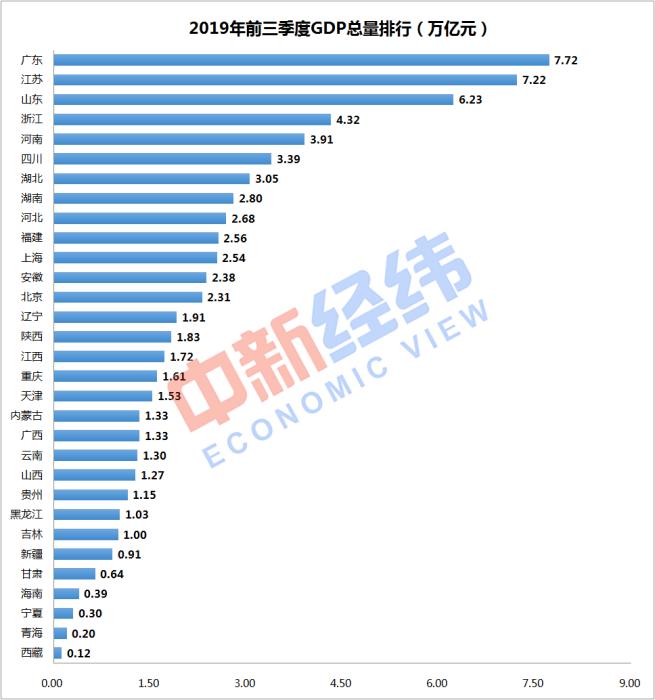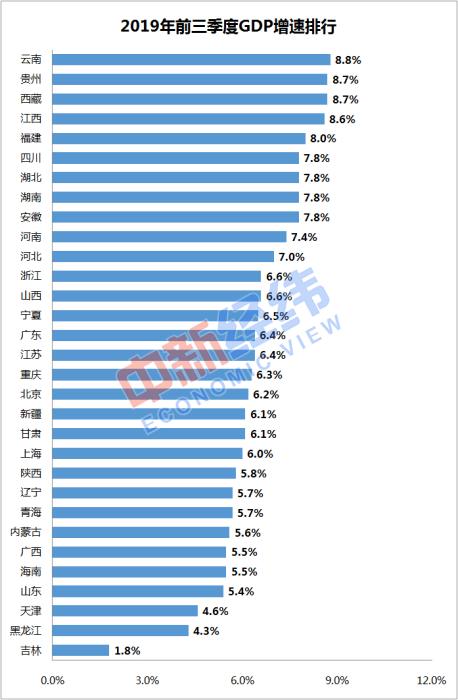GDP of 31 provinces in the first three quarters: Guangdong ranked first, Fujian still surpassed Shanghai and entered the top 10.
Zhongxin Jingwei Client November 16 (Zhang Yunan) On the 16th, the National Bureau of Statistics announced the GDP data of 31 provinces in the first three quarters of 2019. The client of Zhongxin Jingwei noticed that at present, the number of members of the GDP trillion club has expanded to 25, with Guangdong ranking first with 7.72 trillion, and Shandong’s GDP in the first three quarters broke through 6 trillion; In terms of growth rate, the growth rate of 17 provinces outperformed the whole country, and Yunnan ranked first.
Fujian still surpassed Shanghai and entered the top 10 provinces in terms of economic aggregate.

Source of data: Zhang Yunan, a new Jingwei in the website of the National Bureau of Statistics.
In terms of economic aggregate in the first three quarters, Guangdong, Jiangsu, Shandong, Zhejiang, Henan, Sichuan, Hubei, Hunan, Hebei and Fujian ranked in the top 10. Among them, the eastern region accounts for six seats, namely Hebei, Jiangsu, Zhejiang, Fujian, Shandong and Guangdong; The central region occupies three seats, namely Henan, Hubei and Hunan; There is only Sichuan in the western region, accounting for one seat.
Guangdong and Jiangsu became the only two members of the "7 trillion GDP Club" in the first three quarters of this year, with economic aggregates of 7.72 trillion and 7.22 trillion respectively. In the same period last year, Guangdong’s GDP has exceeded 7 trillion yuan, reaching 7.06 trillion yuan.
Shandong is a new member of the "6 trillion yuan club". In the first three quarters of last year, Shandong’s GDP was 5.96 trillion yuan. In the first three quarters of this year, Shandong’s total economic output reached 6.23 trillion yuan, a year-on-year increase of 5.4%. Zhejiang also increased from 3.98 trillion yuan in the first three quarters of last year to 4.32 trillion yuan. In addition, in the first three quarters of this year, the members of the "5 trillion GDP Club" were vacant.
Lu Wanming, deputy director and spokesperson of Shandong Provincial Bureau of Statistics, said that in recent years, Shandong Province has actively promoted the transformation, upgrading and leap-forward development of service industry, and accelerated the deep integration and development of service industry and manufacturing industry, service industry and agriculture. In the first three quarters, the development of service industry was outstanding, and the proportion and contribution of service industry continued to increase, which played the role of "stabilizer" and "booster" for Shandong Province’s economy to maintain an overall stable, steady and progressive trend.
It should also be mentioned that among the top 10 provinces in terms of GDP in the first three quarters of this year, Fujian still surpassed Shanghai with an advantage of about 20 billion yuan, and its economic aggregate ranked 10th in the country.
The growth rate of 17 provinces outperformed the whole country.

Source of data: Zhang Yunan, a new Jingwei in the website of the National Bureau of Statistics.
In the first three quarters of 2019, China’s GDP was 697.798 billion yuan, an increase of 6.2% at comparable prices. Compared with the national level, the GDP growth rate of Yunnan, Guizhou, Tibet, Jiangxi, Fujian, Sichuan, Hubei, Hunan, Anhui, Henan, Hebei, Zhejiang, Shanxi, Ningxia, Guangdong, Jiangsu and Chongqing in the first three quarters outperformed the whole country.
Yunnan’s GDP growth rate of 8.8% in the previous three quarters ranked first. This year’s Yunnan government work report mentioned that Yunnan’s regional GDP growth target in 2019 is about 8.5%. In addition, in the first three quarters, the added value of industrial enterprises above designated size in Yunnan increased by 9.3% year-on-year, and the growth rate was 3.7 percentage points higher than that of the whole country (5.6%). Its real estate data also grew rapidly, and Yunnan’s real estate investment increased by 29.7% in the first three quarters.
In the first three quarters, the GDP growth rate was in the "8 era", including Guizhou, Tibet, Jiangxi and Fujian; The provinces with relatively low growth rates are Jilin, Heilongjiang and Tianjin. The GDP growth rates in the first three quarters were 1.8%, 4.3% and 4.6% respectively, which did not exceed 5%.
For the economic performance of Jilin Province in the first three quarters, the Jilin Provincial Bureau of Statistics said on November 5 that the economy of Jilin Province basically operated smoothly in the first three quarters, but the downward pressure continued to increase, and the growth rate of major economic indicators declined. The data shows that in the first three quarters of Jilin, the added value of industrial enterprises above designated size, investment in fixed assets and import and export volume all declined to varying degrees. Among them, the added value of industrial enterprises above designated size decreased by 0.6% from January to September, 1.1 percentage points lower than the growth rate of 0.5% from January to August; The province’s investment in fixed assets (excluding farmers) decreased by 14.4% year-on-year in the first nine months, which was 4 percentage points higher than that in the previous August.
Jilin Province held the first meeting of the provincial government’s key work exchange in 2019 on July 30, pointing out that steady growth has entered the sprint stage of last stand, Jedi counterattack and decisive battle. It is necessary to aim at the decline of indicators, improve speed, quality and efficiency, and build up stable growth beams and columns.
Compared with last year, in the first three quarters of 2019, the GDP growth rate of Henan, Hunan and Chongqing provinces was the same as that of the same period of last year; The GDP growth rate of Hebei, Tianjin, Inner Mongolia, Shanxi, Liaoning, Xinjiang and Hainan provinces has increased compared with the same period of last year.
The GDP growth rate of Tianjin in the first three quarters was 4.6%, with the year-on-year growth rate increasing the most, reaching 1.1 percentage points. The year-on-year growth rate slowed down significantly in Shaanxi, where the GDP growth rate in the first three quarters was 5.8%, 2.6 percentage points lower than that in the same period last year. This year’s Shaanxi government work report mentioned that the target range of regional GDP growth in Shaanxi in 2019 is 7.5%-8%.
Among the three northeastern provinces, Liaoning is the only province that has achieved a year-on-year growth rate. Its GDP growth rate in the first three quarters was 5.7%, an increase of 0.3 percentage points year-on-year.
How to treat the further slowdown of economic growth in the first three quarters? Mao Shengyong, director and spokesperson of the National Statistics Department of the National Bureau of Statistics, pointed out that since the beginning of this year, the growth of the world economy and international trade has been slowing down, and the domestic economy is under great downward pressure. Judging from the main economic indicators in the first three quarters, the economic operation is generally stable. Judging from the growth rate itself, although it has slowed down, it is among the best in the world’s major economies. Mao Shengyong said that it is initially estimated that this speed is the fastest among the economies with a global economic aggregate of more than one trillion US dollars.
For the fourth quarter GDP data, Mao Shengyong said that the world economy will probably continue to slow down in the next stage, but internally, there are many favorable supporting factors, such as the acceleration of manufacturing PMI in September, the narrowing of the decline in automobile production and sales in the past two months, and the relatively low base in the fourth quarter of last year, so it is guaranteed that the economy will maintain a stable trend in the fourth quarter of this year. (Zhongxin Jingwei APP)